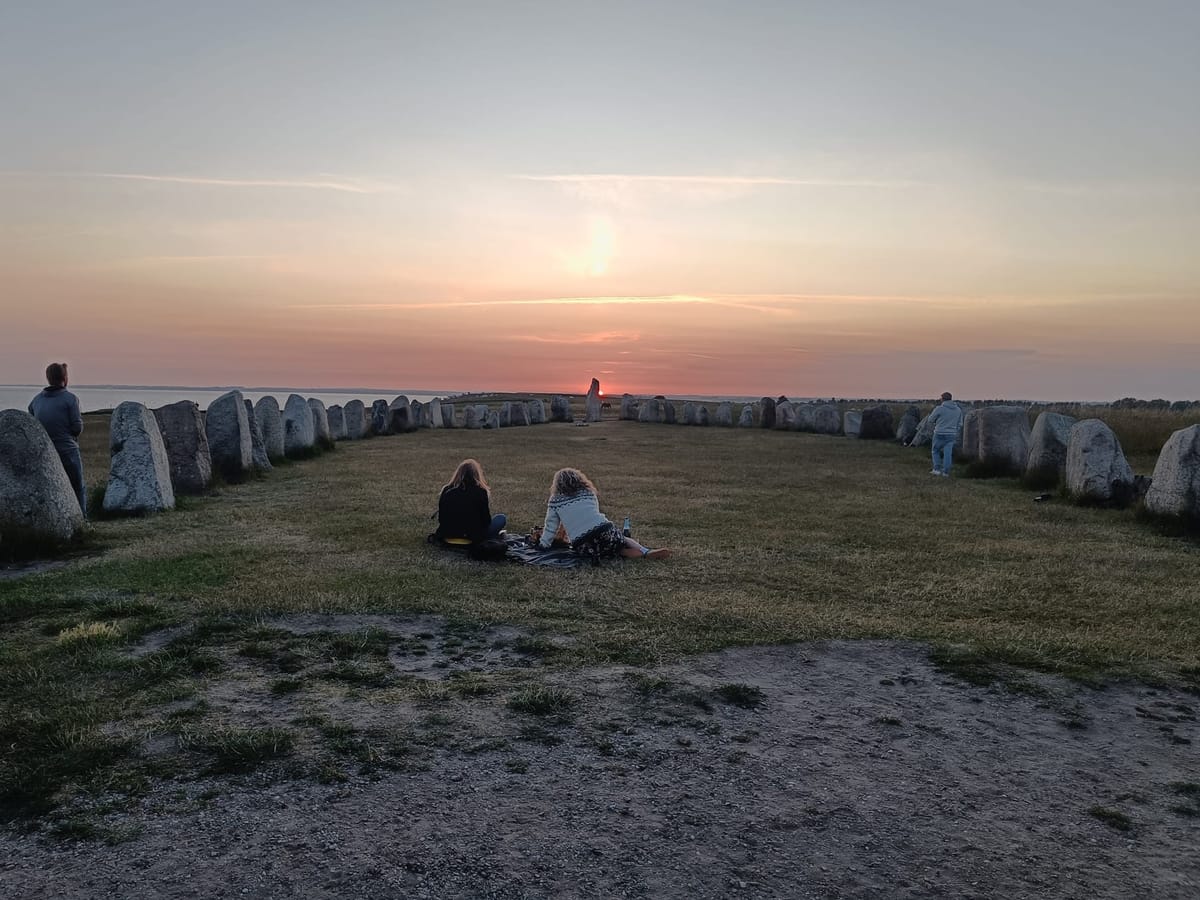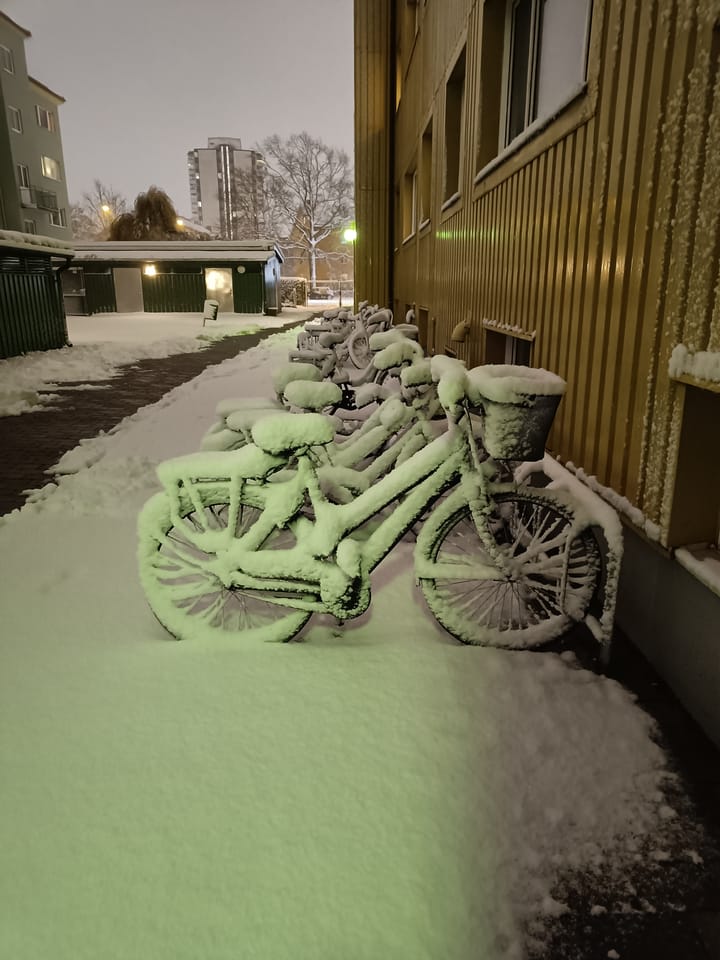week 25 / 2025
The sun sinks behind the prow-stone, and WEEKNOTES sail on toward the summerland... This week, a solstice is observed, both figuratively and literally, and the up/down axis gets an airing.

“WEEKNOTES! Where the demons dwell / where the banshees live, and they do live well...”
Welcome back to WEEKNOTES at Worldbuilding Agency! If you’re wondering why you didn’t get an email version last week, that’s because I did a Minimum Viable Weeknotes (i.e. just my activities ledger, no discussion or reading notes), and figured it was probably of interest only to the hardcore WA headz. (You can see it here, if you want.)
For similar reasons, I’m rearranging the format from this week onward: discursive stuff first, activity ledger second. That way those of you who are interested in what I’ve been reading and thinking about, but perhaps less interested in the minutia of my work-week, can get to the chewy bits without having to scroll through the lists.
Let me know if it works (or if it doesn’t!) by replying to the email or commenting on the site, if you like.
In Sweden, midsommar is a bigger deal than Christmas.
That’s partly due to the way in which the bulk of the country takes their main holiday as one big block that begins with midsommar weekend, an event that is mostly a fairly tradition-driven family affair (though the younger folk often continue with their own more energetic bacchanalia in the evening). Given that people with a stable job can expect to have anywhere between four to six weeks of paid holiday leave per year, this basically means that the whole country goes into sleep mode all through July and into the middle of August, and midsommar marks the formal beginning of this period. Families retreat to their stuga (literally “hut”, but in practice “summer-house”), and the cities for the most part are emptier than usual, modulo whatever tourist activity they get.
Malmö is lucky on the latter front, at least as far as I’m concerned, because it’s not a top-tier tourist draw and therefore doesn’t get swamped. (Rural Skåne is a different matter, however, because a significant chunk of the housing there is owned as summer get-aways by wealthy Stockholmers; it’s also very popular with holidaying Germans who have a taste for nude wild-swimming.) For me, then, midsommar marks the beginning of a period of (hopefully) great weather and relative peace and quiet; the latter is rather more conducive to getting on with work than the former. (No paid holidays for the as-yet still precarious freelance.)
This year midsommar eve fell on June 20th, the very same day as the solstice, and so I did something I’ve been meaning to do since I got here: making my way out to the stone circle known as Ales Stenar, which sits atop a little hill right on the very south-eastern corner of Skåne, overlooking the Baltic as it becomes the Öresund. I was surprised at how few people were at the stones for sundown—see the header image—but I’m told the serious pagans prefer to head off into the woods to whoop it up around a big fire. Perhaps I’ll get an invite to one of those shindigs in years to come? In the meantime, the stones made for a quiet and contemplative few hours, which was exactly what I needed.
(Cycling alone along the back-roads to Ystad through mist-draped fields in the early hours of the morning, in order to sit and wait for the first train back to Malmö, was rather less restful! Though it wasn’t without a certain spooky grandeur.)
reading
On the train back from Stockholm last week I managed to finish Nick Carr’s Superbloom, which I still intend to write about at length for This Very Website. I also worked my way through J F Martel’s fairly short but powerful polemic Reclaiming Art in the Age of Artifice, which is a really good complementary piece to Superbloom, in that it dares advance a rather more substantive response to the banal and relentless instrumentalisation of “content” than does Carr, whose conclusion is basically “it’s a kaleidoscope spiral of dark media design preying ever more effectively on human psychology, but ultimately it wouldn’t work if people didn’t on some level enjoy it, so what can we do but try to extricate ourselves from it and hope it runs its course?”
In that sense, Carr is very much writing from the standard left-liberal USian left-liberal-intelligentsia position—which is to say it’s marked by the unspoken assumption that you just don’t interfere with a market, no matter how deeply dysfunctional and intentionally amok your book relentlessly shows it to be. Martel doesn’t talk much about markets or economics either, but his own suggested strategy of resistance goes beyond withdrawal and retreat: developing your own artistic practice, and seeking out true art (as opposed to the moral rhetorics of what he calls artifice) in your own work and that of others.
In other words, Martel’s position is usefully and gratifyingly close to my own position on futuring—namely that process matters way more than product, and that the work of creating and exploring futures should be deprofessionalised.
(I’ll keep this pinch of powder dry for now, but if it sounds like an argument you’d be interested in, do please keep an eye out for a more involved exploration of it here at WA.)
a clipping
A lot of folk seem to be talking about Dan Zimmer’s essay at Noema about the “up/down” axis in contemporary politics—and not without good reason, as he’s done a pretty neat job of setting the axis out accessibly, as seen from a fairly moderate position thereupon.
Today’s growing political fault line runs deeper than merely a preference for technological or ecological solutions, however, for it turns out that these new servants of Life also disagree on what Life itself is. One camp views Life primarily as an information process to expand and enhance, while the other conceives of Life chiefly as a complex system to maintain and balance. These contrasting perspectives inspire rival political visions: one gazing upward toward Life’s cosmic conquests and the other downward toward Life’s planetary entanglements. They demand a new political language and orientation — neither left nor right — that I propose can best be captured by the contrast between a technological “Up” and an ecological “Down.”
The more we feel caught between technological transcendence and ecological collapse, the more our politics will be reshaped by the conflict between the Up and Down wings over the fate of Life itself.
My beef is less with Zimmer's piece than with the axis concept itself, which I consider to be semantically pre-loaded due to its origins in the transhumanoid community (if one may use that latter noun in the context of a fractious cluster of squabbling libertarian immortalist nut-jobs). As Zimmer explains, transhumanists see themselves as the “up” wing, and while there’s some reasonable symbolic logic to that—after all, extropianism and its descendents have always had one eye on the stars, or rather on the potentially mineral-rich bodies which might be found in orbit around them—it’s also clearly the “white” to posthumanism’s “black”.
As the years have passed, I’ve grown very wary about using the conceptual frames of my opponents, because to do so is to tacitly agree to conduct your contestation on their preferred map of the territory, and thus to put yourself at great disadvantage from the get-go. But, well, it’s been out there for a while, and I suppose I’m sort of glad that we’re talking seriously about these cranks and their technological religion—though I wish that recent scholarship and investigative writing had come up with a less lumpy label for it than “TESCREAL”, and I further wish that our only reason for discussing it could be its sudden and fatal decline.
But if wishes were horses, as the old song goes, then beggars would ride—so I guess it’s time to put on the walking boots once more.
kinmaking
Last weekend saw me up in Stockholm to talk about an interesting new project that Anna Krzywoszynska is involved with. Not sure yet what, if anything, will come of that discussion, but it was good to have it nonetheless—and to spend some quality time with one of my very dearest friends and confidantes from my doctoral days in Sheffield.
Also squeezed in a call with Johan Lager of Point Design, in which we started cooking up a plan for something over the next month or so. Watch this space!
Now, last but not least, the ledger...
ticked off
- Fifteen hours on PROJECT PORTON. (We’re into the crunch phase on the big final deliverable here, so it’s all hands on deck—especially for me, as I’m delivery lead on this thing. I’ll be back on this beat on Sunday afternoon, too.)
- Five hours on PROJECT PONTIF. (Again, just trying to keep this one simmering, with hope of hitting it hard over the summer.)
- Eight hours of admyn. (Probably more, really—but if it don’t get written down, it doesn’t get counted, and this has not been a great week for the quantified self.)
- Ten hours of undirected writing and reading, as always, and a good five hours of reading-for-research on my train ride back from Stockholm, as noted above.
Not a bad week, numbers-wise, but the quality of some of those hours has suffered due to the disruption of regular scheduling by travel and such. One of the good things about doing this sort of self-analysis is you not only notice when you’ve had a sub-par week, but also why. At this stage of my life, it shouldn’t really feel like news to be confronted with my reliance on routine, but, well—better late than never, eh?
OK, that’s all for now. Let me know what you think of the new format, if you have any feelings either way. And glad midsommar to you all!
This has been the Worldbuilding Agency weeknotes for Week 25 of 2025. Thanks for reading! If you've enjoyed them, it's free to subscribe. If you are already subscribed, please send to a friend who you think might also like it!





Comments ()